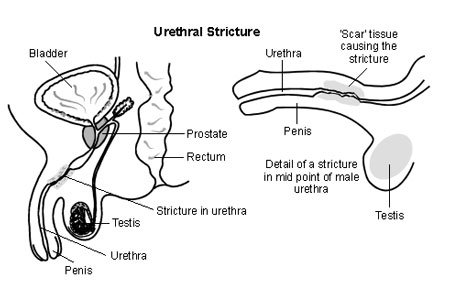- Home
- About Us
- Conditions Treated
- Treatment Offered
- Testimonials
- Gallery
- News And Events
- Urology & Andrology
- Blogs
- Contact Us
Urethral stricture could be defined as the narrowing of the urethra. This will impact the flow of urine out of the bladder.
Inflammation of the urethra can lead to scarring, which then can, in turn, result in stricture or narrowing of the urethra. Urethral stricture is more prevalent in men in comparison to women.

Causes
Symptoms
Diagnosis
The diagnosis and tests conducted for evaluating urethral stricture include:
Treatment
Surgery is the only option for symptoms of urethral narrowing.
Different types of surgical procedures are performed for treating urethral strictures. Some of the common procedures include:
Urethral dilation
Urethral dilation is a common technique used for the treatment of urethral strictures. This procedure is generally done under local or general anaesthesia. In this process, thin rods of varying diameters are gently inserted into the urethra through the tip of the penis so as to open up or widen the urethral narrowing without causing damage to the urethra. This procedure usually has to be repeated from time to time, as strictures have the chance of recurring.
patients can be taught to do self dilatation
Endoscopic optical Urethrotomy
Urethrotomy refers to an endoscopic procedure that is generally performed under general anaesthesia. An endoscope is inserted into the urethra to clearly view the stricture. Then, a small knife is passed through the endoscope in order to sever the stricture lengthwise to facilitate the smooth flow of urine. A urinary catheter is inserted and kept in position for some days while the incision is healing.
Open reconstruction (Urethroplasty)
Open reconstruction involves various techniques for the correction of urethral strictures. If the stricture segment is short, it can be excise and the normal-looking both upper and lower ends of the urethra can be joined together. This is called Excision urethroplasty.
If the strictured segment is long, the stricture site is opened up and suitable graft material is usually taken from cheek mucosa or from the lip and is sutured over the opened area to provide wider urethral lumen( Substitution urethroplasty)
Get in touch with us
Testimonials
About Dr. N. Anandan

Dr. N. Anandan is a senior consultant at Kauvery hospital and Apollo spectra hospitals in Chennai
Read MoreTreatments
Conditions Treated
Treatments Offered